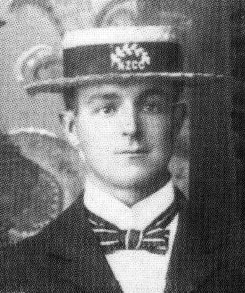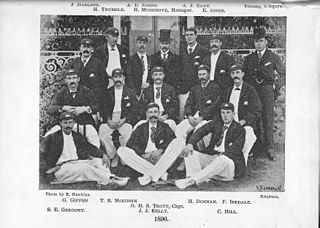Related Research Articles

Frederick Theodore Badcock was a New Zealand first-class and Test cricketer. Perhaps the best all-rounder in New Zealand in the inter-war period, he played seven Test matches for New Zealand between 1930 and 1933, including New Zealand's inaugural Test in 1930. He was the first players capped by New Zealand.
During the 1882–83 New Zealand cricket season, the first class cricket consisted of six matches: an Auckland team went on a tour in December including three games, two in the South Island and in Wellington on the southern tip of the North Island, and three further local clashes.

An English team raised by the Marylebone Cricket Club (MCC) toured New Zealand between December 1906 and March 1907. The tour comprised two first-class matches against New Zealand, two each against the four main provincial teams – Auckland, Canterbury, Otago and Wellington – and one against Hawke's Bay. There were also five minor matches against teams from country areas.
This article describes the history of New Zealand cricket from the 1890–91 season until 1918.
This article describes the history of New Zealand cricket from the 1918–19 season until 1945.
This article describes the history of New Zealand cricket from the 1945–46 season until 1970.

An Australian team toured New Zealand and Fiji from February to April 1905 to play four first-class matches including two against New Zealand, which had not then attained Test status. Although it was the fifth Australian team to tour New Zealand, it was the first one to play matches on even terms, which therefore have first-class status. On previous tours all matches had been against teams of 15, 18 or 22 players. As well as the two matches against New Zealand, the Australians played first-class matches against Canterbury and Otago. The other games were non-first-class against Auckland, Wellington and Fiji.
An Australian cricket team toured New Zealand from February to April 1921 to play nine first-class matches including two against New Zealand. The Australians also played the main provincial teams.
The Australia national cricket team toured New Zealand from February to April 1928 and played six first-class matches including two against the New Zealand national cricket team. This was before New Zealand began playing Test cricket.

While the Australian Test team was touring South Africa in the 1949–50 season, another Australian team captained by Bill Brown played 14 matches in New Zealand between February and April 1950, five of which were first-class. These included one match against the New Zealand national cricket team, but this was not granted Test status.
An Australian national cricket team captained by Ian Craig toured New Zealand between February and April 1957. They played 12 matches, seven of which were first-class, including three matches against New Zealand, but these were not granted Test status. The Australians won one and drew two of the international matches, and won the other four first-class matches.

Lord Hawke selected a cricket team of ten amateurs and two professional players to tour Australia and New Zealand from November 1902 until March 1903. After an opening game in San Francisco, the tour began of eighteen matches - seven of them considered first-class - in New Zealand followed by three further first-class games in Australia. Hawke's team was the first to tour Australasia with New Zealand as the primary destination and, as was the norm at the time, was privately run and funded. The Australian leg of the tour was a "profit making venture", however the games in New Zealand were scheduled at the behest of the New Zealand Cricket Board in order to raise the profile of cricket in the country. Two of them were against a New Zealand cricket team, before its international Test status. The inclusion of such games on the tour were considered "a sign that cricket in New Zealand was starting to be taken more seriously, and a move towards official international status was possible."
Thomas Andrew Carlton was an Australian cricketer who played first-class cricket in New Zealand and Australia from 1909 to 1932.

Arnold Butler Williams was a Welsh-born cricketer who played first-class cricket for Otago and Wellington between the 1886–87 and 1909–10 seasons, and captained New Zealand in the days before New Zealand played Test cricket.

Frank Stanley Frankish was a cricketer who played first-class cricket for Canterbury from 1894 to 1903, and played for New Zealand in the days before New Zealand played Test cricket.
Charles Augustus Richardson was an Australian-born cricketer who captained the New Zealand cricket team and scored its first century. He also scored the world's first first-class century of the 1900s.
The Australian cricket team toured New Zealand in January and February 1878, before their 1878 tour of England. It was the first overseas tour by a representative Australian team.
The Australian cricket team toured New Zealand in January and February 1881. The Australians played ten matches against provincial teams, nine of which fielded 22 players with the aim of providing more evenly-matched contests. Two further brief matches were played to fill the allotted time after a scheduled match finished early. As none of the matches were 11-a-side they are not considered to have been first-class.
The Australian cricket team toured New Zealand in late November and early December 1886.

The Australian cricket team toured New Zealand in November 1896, playing five matches. They were returning from their 1896 tour of England.
References
- ↑ "New Zealand Cricket in the 19th Century" (PDF). Winter Newsletter. New Zealand Cricket Museum. 2009. Archived from the original (PDF) on 9 February 2013. Retrieved 22 December 2013.
- ↑ D.O & P.W. Neely, The Summer Game, 1994, p11.
- ↑ Barclays World of Cricket, 2nd edition, Collins Publishers, 1980, ISBN 0-00-216349-7, p90.
- ↑ "Canterbury v Otago 1868–69". CricketArchive. Retrieved 25 January 2017.
- ↑ "First-Class matches in New Zealand 1873/74". CricketArchive. Retrieved 16 April 2019.
- ↑ "Canterbury v Otago 1880–81". CricketArchive. Retrieved 25 January 2017.
- ↑ https://cricketarchive.com/Archive/Events/2/Tasmania_in_New_Zealand_1883-84.html CricketArchive tour itinerary
- ↑ CricketArchive tour itinerary
- ↑ CricketArchive tour itinerary
- 1 2 "Cricket history: Recorded by Tom Reese: Dominion's best team from 1860 to 1914". Nelson Evening Mail. 31 March 1927. p. 4.